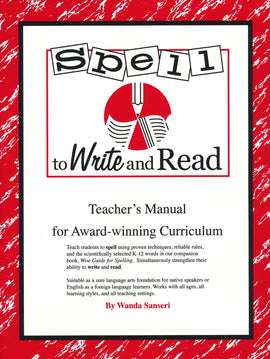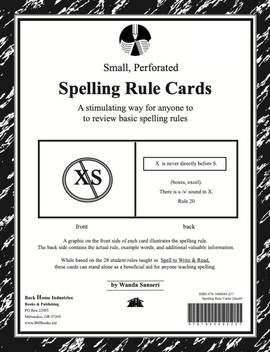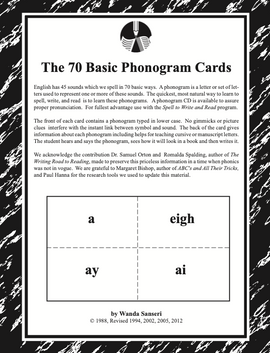Cursive First: An Introduction to Cursive Penmanship, 2nd edition
Why teach cursive first?
Historically cursive was taught first to our nation's children. Today, reading and dyslexia experts are rediscovering that teaching cursive first--before print or manuscript--improves long-term penmanship skills, helps children learn to read, virtually eliminates reversals, and enables children to read what is written by others. Cursive First introduces children to writing numerals, the cursive alphabet, and the most common phonograms of the English language. The package coordinates with the instruction found in the highly successful Spell to Write and Read and The WISE Guide by Wanda
For an abridged version of the first chapter from Cursive First (2nd Edition) on the Rationales for teaching cursive for initial penmanship, click on
This kit includes -
- Cursive First Teacher's Guide, 32 pages, paperback
- 28 Instruction Cards + numbers, printed on 8 sheets of cardstock
- 45 Practice Sheets, reproducible loose-leaf
The Teacher's Manual includes discussion and instruction about
* the rationales for teaching cursive first
* developmental considerations and preparing the child
* the reference tools used to teach penmanship
* how to teach cursive penmanship to
* how to use the Practice Sheets
* detecting visual and perceptual problems
The Practice Sheets
* include detailed instruction and dialogue for teaching numerals, cursive strokes and the first 26 phonograms
* utilize narrow ruled, dotted lines for practice
* provide brief and specific practice of phonograms under current study
* teach lower case letters separately from capital letters
* teach connections between letters from the very beginning and in the natural context of
* provide solid and dotted line models for writing, but quickly wean the student from tracing to more active learning and writing
* can be used as masters to copy as many times as needed for each child in your classroom or family
The Cursive Phonogram Card Set
* provides practice for reading first 26 phonograms in cursive to encourage instant recall
* includes instructional dialogue for writing the phonograms and sample of cursive writing
* ready to cut apart and laminate for durability
* includes instruction cards for teaching numerals and cursive letters
* printed on yellow cardstock to differentiate them from other phonogram or spelling rule cards
Advantages of Cursive First, 2nd Edition
MULTIPLE AGE ADAPTABILITY - Cursive instruction manuals are marketed for students in
EFFICIENT PAPER USE - Most penmanship books have page after page of beautifully illustrated practice sheets with very little room for actual writing practice. Kathy Libby has said, "Perhaps large American educational publishers, those that provide expensive, beautiful, four-color practice books, ought to reevaluate the quality of their materials. I observe that the amount of actual practice per page is reduced by colorful cute pictures, robbing attention and space from the goal of developing fluent cursive" (Francis, 2000). Every practice page in Cursive First is completely dedicated to practicing penmanship without wasting paper or distracting young writers with busy pictures.
PHONOGRAMS ORDERED FOR MOTOR PATTERN REINFORCEMENT - Other manuals introduce the letters in alphabetical order, but knowing the alphabetical order is important for dictionary work, not for learning how to write them. In Cursive First, the letters are introduced according to the first strokes used to form the letter, thus reinforcing new motor patterns.
LOWER-CASE LETTERS TAUGHT SEPARATELY - The prevailing practice with penmanship books is to teach capital letters on the same page as their lower-case partners. According to Spalding, the student needs to have learned the lower-case letters well before being introduced to the capital letters (Spalding, 1990). Hilde Mosse also warned, "The best way to teach writing from kindergarten on is to use one style of letters only." (Mosse, 1982) Capital letters are used much less frequently than their lower-case partners. Also, by delaying the teaching of capitals, we demonstrate to the child that English has rules which dictate where the capitals are required. The lower-case letters are introduced in Cursive First before capital letters are taught. The exception to this rule is teaching children the capital letters that start their names.
CLOCKFACE REFERENCE TOOL USE - No other manuals for cursive incorporate the clockface as a directional teaching device. This crucial element of Spalding's method for writing instruction was too valuable to lose. The clockface is used in Cursive First for writing the first six phonograms, several of the numerals, and as a reference point for many other letters.
MORE THAN A COPYBOOK - Many penmanship books amount to nothing more than copybooks with little or no instructions to guide the student or teacher. Libby noticed that instead of teaching handwriting skills, most workbooks use the instruction set known as "trace and write," leaving the children to figure out the starting and stopping points of letters (Francis, 2000). Cursive First offers detailed instructions for the teacher to ensure that the student is properly taught the penmanship skills necessary to a fluent, neat and legible cursive hand.
NARROW-RULED PRACTICE PAGES - Penmanship publishers use wide-lined paper for Kindergartners and first graders with narrower lines for older students. Contrary to popular opinion, writing on larger spaced lines is harder for young children than writing on narrower lined paper. Larger lines require greater control of the writing instrument to maneuver the larger space and
COST-EFFECTIVE & REPRODUCIBLE - Penmanship instruction is typically packaged in expensive consumable workbooks. Cursive First offers the teacher practice pages to copy for all of her students as many times as needed so that mastery of the letters and
NUMERAL WRITING INSTRUCTION - A kindergarten student not only must master the skill of writing his letters and
WISE GUIDE COORDINATION - Cursive First was designed to coordinate specifically with the phonograms used in SWR and with the order of presentation for the
TEACHING TOOLS INCORPORATION - Finally, unlike other copybooks, Cursive First includes a set of cards to assist the instructor in teaching the numerals and phonograms. The cards can be used within reading and spelling lessons to further reinforce the sound-symbol relationship.
We suggest that for Cursive First to be well rounded, please consider purchasing the 70 Basic
ISBN 9780974492018
| Book Title | Cursive First: An Introduction to Cursive Penmanship, 2nd edition |
| Publisher: | Liz FitzGerald - LITHBTH Educational Services |
| Author | Elizabeth FitzGerald, M.S. |
Why teach cursive first?
Historically cursive was taught first to our nation's children. Today, reading and dyslexia experts are rediscovering that teaching cursive first--before print or manuscript--improves long-term penmanship skills, helps children learn to read, virtually eliminates reversals, and enables children to read what is written by others. Cursive First introduces children to writing numerals, the cursive alphabet, and the most common phonograms of the English language. The package coordinates with the instruction found in the highly successful Spell to Write and Read and The WISE Guide by Wanda
For an abridged version of the first chapter from Cursive First (2nd Edition) on the Rationales for teaching cursive for initial penmanship, click on
Abridged Rationales for Cursive First Penmanship Instruction
This kit includes -
- Cursive First Teacher's Guide, 32 pages, paperback
- 28 Instruction Cards + numbers, printed on 8 sheets of cardstock
- 45 Practice Sheets, reproducible loose-leaf
The Teacher's Manual includes discussion and instruction about
* the rationales for teaching cursive first
* developmental considerations and preparing the child
* the reference tools used to teach penmanship
* how to teach cursive penmanship to
* how to use the Practice Sheets
* detecting visual and perceptual problems
The Practice Sheets
* include detailed instruction and dialogue for teaching numerals, cursive strokes and the first 26 phonograms
* utilize narrow ruled, dotted lines for practice
* provide brief and specific practice of phonograms under current study
* teach lower case letters separately from capital letters
* teach connections between letters from the very beginning and in the natural context of
* provide solid and dotted line models for writing, but quickly wean the student from tracing to more active learning and writing
* can be used as masters to copy as many times as needed for each child in your classroom or family
The Cursive Phonogram Card Set
* provides practice for reading first 26 phonograms in cursive to encourage instant recall
* includes instructional dialogue for writing the phonograms and sample of cursive writing
* ready to cut apart and laminate for durability
* includes instruction cards for teaching numerals and cursive letters
* printed on yellow cardstock to differentiate them from other phonogram or spelling rule cards
Advantages of Cursive First, 2nd Edition
MULTIPLE AGE ADAPTABILITY - Cursive instruction manuals are marketed for students in
EFFICIENT PAPER USE - Most penmanship books have page after page of beautifully illustrated practice sheets with very little room for actual writing practice. Kathy Libby has said, "Perhaps large American educational publishers, those that provide expensive, beautiful, four-color practice books, ought to reevaluate the quality of their materials. I observe that the amount of actual practice per page is reduced by colorful cute pictures, robbing attention and space from the goal of developing fluent cursive" (Francis, 2000). Every practice page in Cursive First is completely dedicated to practicing penmanship without wasting paper or distracting young writers with busy pictures.
PHONOGRAMS ORDERED FOR MOTOR PATTERN REINFORCEMENT - Other manuals introduce the letters in alphabetical order, but knowing the alphabetical order is important for dictionary work, not for learning how to write them. In Cursive First, the letters are introduced according to the first strokes used to form the letter, thus reinforcing new motor patterns.
LOWER-CASE LETTERS TAUGHT SEPARATELY - The prevailing practice with penmanship books is to teach capital letters on the same page as their lower-case partners. According to Spalding, the student needs to have learned the lower-case letters well before being introduced to the capital letters (Spalding, 1990). Hilde Mosse also warned, "The best way to teach writing from kindergarten on is to use one style of letters only." (Mosse, 1982) Capital letters are used much less frequently than their lower-case partners. Also, by delaying the teaching of capitals, we demonstrate to the child that English has rules which dictate where the capitals are required. The lower-case letters are introduced in Cursive First before capital letters are taught. The exception to this rule is teaching children the capital letters that start their names.
CLOCKFACE REFERENCE TOOL USE - No other manuals for cursive incorporate the clockface as a directional teaching device. This crucial element of Spalding's method for writing instruction was too valuable to lose. The clockface is used in Cursive First for writing the first six phonograms, several of the numerals, and as a reference point for many other letters.
MORE THAN A COPYBOOK - Many penmanship books amount to nothing more than copybooks with little or no instructions to guide the student or teacher. Libby noticed that instead of teaching handwriting skills, most workbooks use the instruction set known as "trace and write," leaving the children to figure out the starting and stopping points of letters (Francis, 2000). Cursive First offers detailed instructions for the teacher to ensure that the student is properly taught the penmanship skills necessary to a fluent, neat and legible cursive hand.
NARROW-RULED PRACTICE PAGES - Penmanship publishers use wide-lined paper for Kindergartners and first graders with narrower lines for older students. Contrary to popular opinion, writing on larger spaced lines is harder for young children than writing on narrower lined paper. Larger lines require greater control of the writing instrument to maneuver the larger space and
COST-EFFECTIVE & REPRODUCIBLE - Penmanship instruction is typically packaged in expensive consumable workbooks. Cursive First offers the teacher practice pages to copy for all of her students as many times as needed so that mastery of the letters and
NUMERAL WRITING INSTRUCTION - A kindergarten student not only must master the skill of writing his letters and
WISE GUIDE COORDINATION - Cursive First was designed to coordinate specifically with the phonograms used in SWR and with the order of presentation for the
TEACHING TOOLS INCORPORATION - Finally, unlike other copybooks, Cursive First includes a set of cards to assist the instructor in teaching the numerals and phonograms. The cards can be used within reading and spelling lessons to further reinforce the sound-symbol relationship.
We suggest that for Cursive First to be well rounded, please consider purchasing the 70 Basic
ISBN 9780974492018






